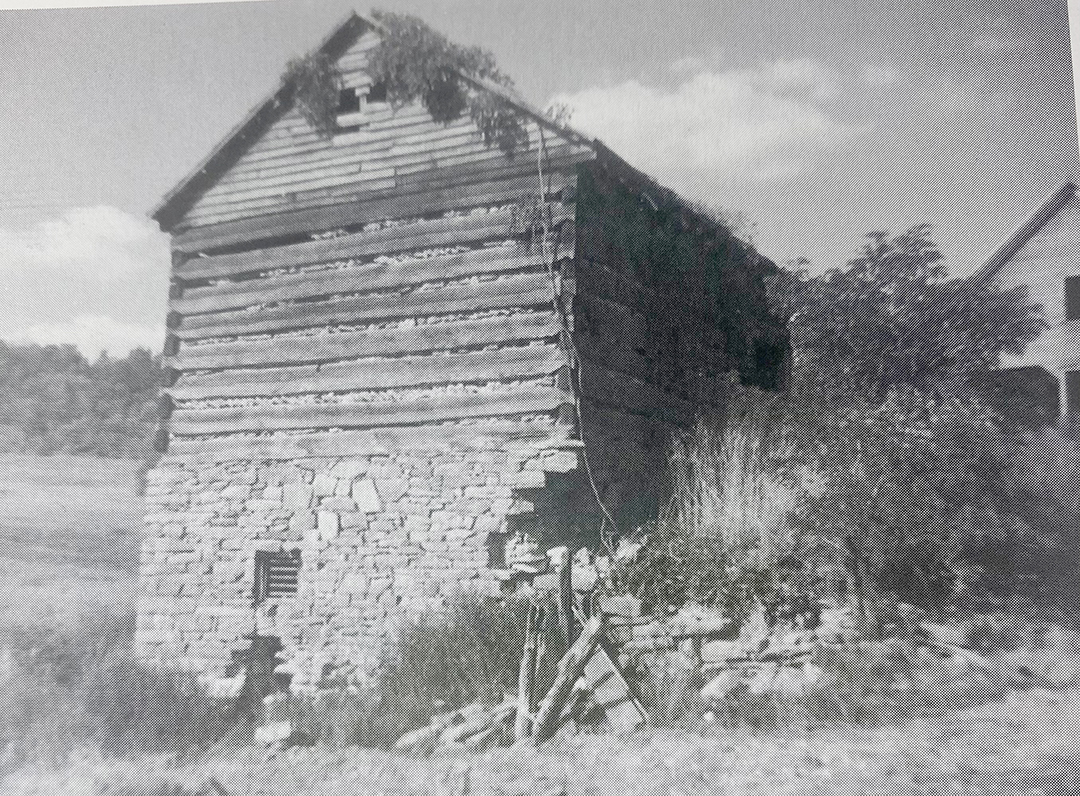The house was right over there,” Eugene Lemley leans out the car window, pointing to the middle of Lake Wilma. The dirt road we’re on is the conduit between the man-made lake and its backwater on the other side. “The barn was up the hill. I grew up on the farm working with my grandfather – that was home. I’ve walked every inch. Hunted every hill.” We’re in Wayne Township, Greene County, not far from the Mason-Dixon line, taking in the crisp October hills and still waters that were once Eugene’s Chalfont family farm.
Eugene pulls off the road and gestures again. “It’s down there.” I get out and follow the ribbon-thin path down the embankment to the backwater side, pushing through underbrush to a flat place that seems carved out of the hill. Peeking through the overhang I see the remains of a stone foundation. I’m here to see what’s left of Brice and Nathan Worleys’ fort.
Lawrence Tennant’s photo in The Blacksville Story, page 34, shows what the old log cabin fortress, built in the early 1770s, looked like in the 1980s. Consolidation Coal Co. was preparing to flood the meadow on the left with the backwaters of Lake Wilma. The caption reads, “…despite the protests of citizens, the historic frontier building was destroyed.”
 Lake Wilma was dammed in the 1960s after Consolidated Coal bought the 395-acre farm. “I came home from service and found out my uncle sold it. So I moved to town and bought the place I’m in now beside the church.” Eugene still remembers the old fort, remembers playing in it as a kid, remembers working the land with his grandfather and cousins. “We kept cows in it.”
Lake Wilma was dammed in the 1960s after Consolidated Coal bought the 395-acre farm. “I came home from service and found out my uncle sold it. So I moved to town and bought the place I’m in now beside the church.” Eugene still remembers the old fort, remembers playing in it as a kid, remembers working the land with his grandfather and cousins. “We kept cows in it.”
Another photo on the page shows the old cabin in 1900 when it was still three stories high and a private residence. The bottom two stories were usually protected by stockade when it was protecting settlers, the top floor was where riflemen fired at advancing intruders. Brice and Nathan Worley were Quakers and surveyors from Penn’s Colony. They helped Mason and Dixon survey most of western Pennsylvania before settling near Blacksville in 1764-66. As surveyors, they managed to put their land on the Penn’s Woods side of the line that had yet to be drawn. At some point during those early years, Nathan Worley lost his life to an indigenous sniper as he stood in an upstairs doorway, listening to what he thought was a turkey call. The Blacksville Story tells us Brice Worley’s grandson John was born on the farm in 1823.
When Solomon Chalfont bought the farm he removed the top story, redid the roof and turned it into a barn. Now all that’s left is hard packed earth and some retaining walls – and a fine view of still waters and tree covered hills.
The charred wood of a campfire on the flat ground next to the bank shows that Worley’s fort is still there for those who come to relax, enjoy nature and maybe fish on the backwater side of Lake Wilma.
